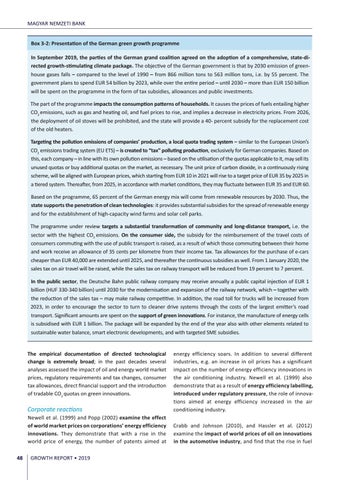MAGYAR NEMZETI BANK Box 3-2: Presentation of the German green growth programme In September 2019, the parties of the German grand coalition agreed on the adoption of a comprehensive, state-directed growth-stimulating climate package. The objective of the German government is that by 2030 emission of greenhouse gases falls – compared to the level of 1990 – from 866 million tons to 563 million tons, i.e. by 55 percent. The government plans to spend EUR 54 billion by 2023, while over the entire period – until 2030 – more than EUR 150 billion will be spent on the programme in the form of tax subsidies, allowances and public investments. The part of the programme impacts the consumption patterns of households. It causes the prices of fuels entailing higher CO2 emissions, such as gas and heating oil, and fuel prices to rise, and implies a decrease in electricity prices. From 2026, the deployment of oil stoves will be prohibited, and the state will provide a 40- percent subsidy for the replacement cost of the old heaters. Targeting the pollution emissions of companies’ production, a local quota trading system – similar to the European Union’s CO2 emissions trading system (EU ETS) – is created to “tax” polluting production, exclusively for German companies. Based on this, each company – in line with its own pollution emissions – based on the utilisation of the quotas applicable to it, may sell its unused quotas or buy additional quotas on the market, as necessary. The unit price of carbon dioxide, in a continuously rising scheme, will be aligned with European prices, which starting from EUR 10 in 2021 will rise to a target price of EUR 35 by 2025 in a tiered system. Thereafter, from 2025, in accordance with market conditions, they may fluctuate between EUR 35 and EUR 60. Based on the programme, 65 percent of the German energy mix will come from renewable resources by 2030. Thus, the state supports the penetration of clean technologies: it provides substantial subsidies for the spread of renewable energy and for the establishment of high-capacity wind farms and solar cell parks. The programme under review targets a substantial transformation of community and long-distance transport, i.e. the sector with the highest CO2 emissions. On the consumer side, the subsidy for the reimbursement of the travel costs of consumers commuting with the use of public transport is raised, as a result of which those commuting between their home and work receive an allowance of 35 cents per kilometre from their income tax. Tax allowances for the purchase of e-cars cheaper than EUR 40,000 are extended until 2025, and thereafter the continuous subsidies as well. From 1 January 2020, the sales tax on air travel will be raised, while the sales tax on railway transport will be reduced from 19 percent to 7 percent. In the public sector, the Deutsche Bahn public railway company may receive annually a public capital injection of EUR 1 billion (HUF 330-340 billion) until 2030 for the modernisation and expansion of the railway network, which – together with the reduction of the sales tax – may make railway competitive. In addition, the road toll for trucks will be increased from 2023, in order to encourage the sector to turn to cleaner drive systems through the costs of the largest emitter’s road transport. Significant amounts are spent on the support of green innovations. For instance, the manufacture of energy cells is subsidised with EUR 1 billion. The package will be expanded by the end of the year also with other elements related to sustainable water balance, smart electronic developments, and with targeted SME subsidies. The empirical documentation of directed technological change is extremely broad; in the past decades several analyses assessed the impact of oil and energy world market prices, regulatory requirements and tax changes, consumer tax allowances, direct financial support and the introduction of tradable CO2 quotas on green innovations.
48
Corporate reactions
energy efficiency soars. In addition to several different industries, e.g. an increase in oil prices has a significant impact on the number of energy efficiency innovations in the air conditioning industry. Newell et al. (1999) also demonstrate that as a result of energy efficiency labelling, introduced under regulatory pressure, the role of innovations aimed at energy efficiency increased in the air conditioning industry.
Newell et al. (1999) and Popp (2002) examine the effect of world market prices on corporations’ energy efficiency innovations. They demonstrate that with a rise in the world price of energy, the number of patents aimed at
Crabb and Johnson (2010), and Hassler et al. (2012) examine the impact of world prices of oil on innovations in the automotive industry, and find that the rise in fuel
GROWTH REPORT • 2019
